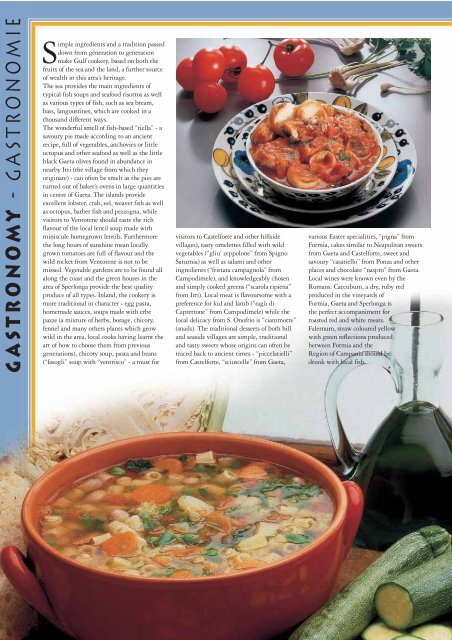APT 1 parte mare gaeta_inglese 3-08
APT 1 parte mare gaeta_inglese 3-08
APT 1 parte mare gaeta_inglese 3-08
Sie wollen auch ein ePaper? Erhöhen Sie die Reichweite Ihrer Titel.
YUMPU macht aus Druck-PDFs automatisch weboptimierte ePaper, die Google liebt.
GASTRONOMY - GASTRONOMIE<br />
Simple ingredients and a tradition passed<br />
down from generation to generation<br />
make Gulf cookery, based on both the<br />
fruits of the sea and the land, a further source<br />
of wealth in this area’s heritage.<br />
The sea provides the main ingredients of<br />
typical fish soups and seafood risottos as well<br />
as various types of fish, such as sea bream,<br />
bass, langoustines, which are cooked in a<br />
thousand different ways.<br />
The wonderful smell of fish-based “tiella” - a<br />
savoury pie made according to an ancient<br />
recipe, full of vegetables, anchovies or little<br />
octopus and other seafood as well as the little<br />
black Gaeta olives found in abundance in<br />
nearby Itri (the village from which they<br />
originate) - can often be smelt as the pies are<br />
turned out of baker’s ovens in large quantities<br />
in centre of Gaeta. The islands provide<br />
excellent lobster, crab, eel, weaver fish as well<br />
as octopus, barber fish and pezzogna, while<br />
visitors to Ventotene should taste the rich<br />
flavour of the local lentil soup made with<br />
miniscule homegrown lentils. Furthermore<br />
the long hours of sunshine mean locally<br />
grown tomatoes are full of flavour and the<br />
wild rocket from Ventotene is not to be<br />
missed. Vegetable gardens are to be found all<br />
along the coast and the green houses in the<br />
area of Sperlonga provide the best quality<br />
produce of all types. Inland, the cookery is<br />
more traditional in character - egg pasta,<br />
homemade sauces, soups made with erbe<br />
pazze (a mixture of herbs, borage, chicory,<br />
fennel and many others plants which grow<br />
wild in the area, local cooks having learnt the<br />
art of how to choose them from previous<br />
generations), chicory soup, pasta and beans<br />
(“fasogli” soup with “ventrisco” - a must for<br />
3 0<br />
visitors to Castelforte and other hillside<br />
villages), tasty omelettes filled with wild<br />
vegetables (“gliu’ zeppolone” from Spigno<br />
Saturnia) as well as salami and other<br />
ingredients (“frittata campagnola” from<br />
Campodimele), and knowledgeably chosen<br />
and simply cooked greens (“scarola ripiena”<br />
from Itri). Local meat is flavoursome with a<br />
preference for kid and lamb (“ragù di<br />
Caprettone” from Campodimele) while the<br />
local delicacy from S. Onofrio is “ciammotte”<br />
(snails). The traditional desserts of both hill<br />
and seaside villages are simple, traditional<br />
and tasty sweets whose origins can often be<br />
traced back to ancient times - “piccelatielli”<br />
from Castelforte, “sciuscelle” from Gaeta,<br />
various Easter specialities, “pigna” from<br />
Formia, cakes similar to Neapolitan sweets<br />
from Gaeta and Castelforte, sweet and<br />
savoury “casatiello” from Ponza and other<br />
places and chocolate “naspro” from Gaeta.<br />
Local wines were known even by the<br />
Romans: Caecubum, a dry, ruby red<br />
produced in the vineyards of<br />
Formia, Gaeta and Sperlonga is<br />
the perfect accompaniment for<br />
roasted red and white meats.<br />
Falernum, straw coloured yellow<br />
with green reflections produced<br />
between Formia and the<br />
Region of Campania should be<br />
drunk with local fish.

















